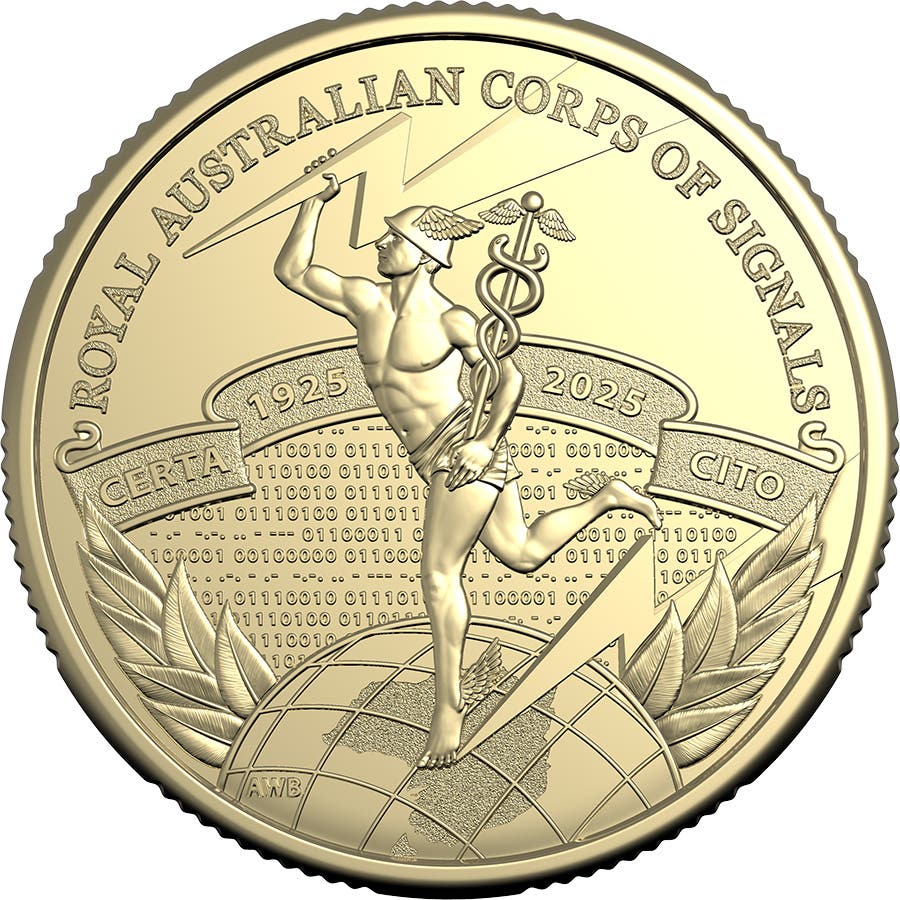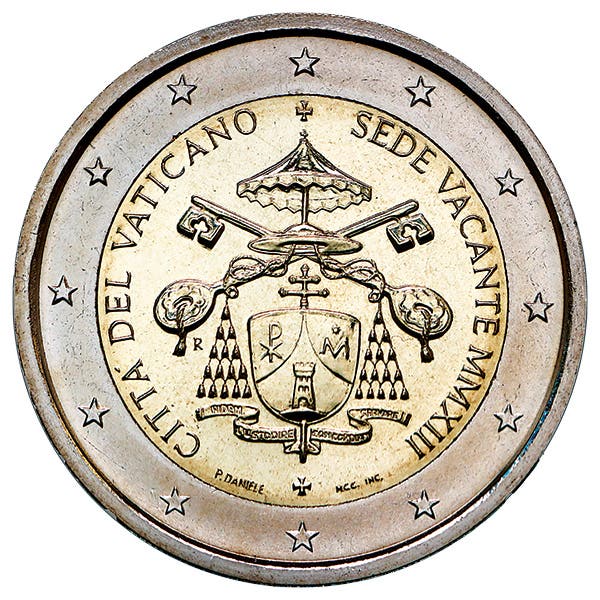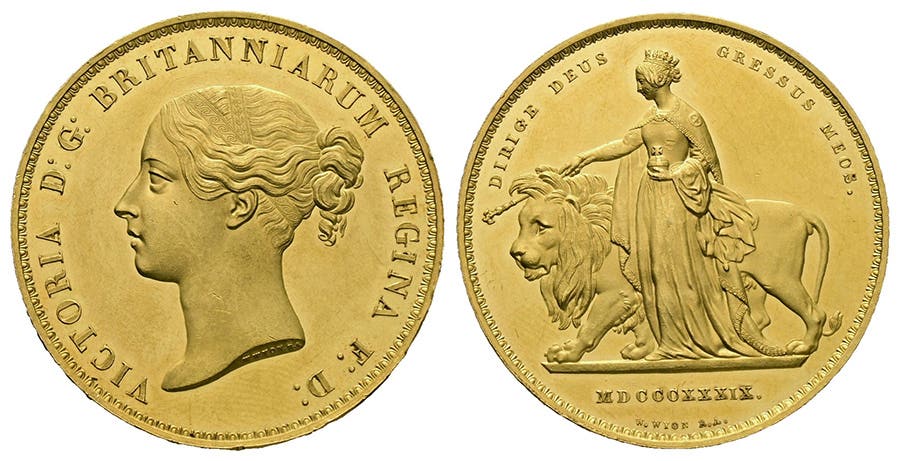The Silver Coinage of Russia 1801-1805
Alexander I became the czar of Russia when his father, Paul I, was murdered in March 1801. It was a traumatic experience from which Alexander never fully recovered. Many of…
Alexander I became the czar of Russia when his father, Paul I, was murdered in March 1801. It was a traumatic experience from which Alexander never fully recovered. Many of his actions, or failures to act during his reign of nearly 25 years, can be attributed to this Greek tragedy with which his rule began.
The officer clique that murdered Paul had asked for Alexander’s silent aid in overthrowing his father because they claimed that the Czar had gone mad and needed to be sent into some kind of pleasant exile within Russia. Of course, the officers had no such intention in mind and when the deed was done, they tearfully informed Alexander of the unfortunate “accident.” The same accident had befallen Peter III, Paul’s father, in June 1762 when he too was murdered.
The 1801-dated coinage of Paul continued throughout that year as Alexander took his time in considering just what designs he wanted for the gold, silver, and copper to be issued under the new regime. Paul had done away with portraits on the silver and gold coinage, the copper never having had any to begin with, and Alexander ultimately decided to keep this precedent intact. Portrait coins would not appear again on Russian coins until 1886. (Alexander’s portrait did appear on the Polish coins struck at Warsaw. Much of the old Polish kingdom was now part of Imperial Russia and the portrait appeared in Alexander’s role as king of Poland.)
The coronation for Alexander I was held in the Moscow Kremlin as had been the custom for centuries. The September 1801 ceremony was marked by a silver jeton carrying the Czar’s initial on the obverse and a statement indicating the date of the ceremony. These jetons were distributed widely to the public and those attending the coronation. Large coronation medals were also struck for special distribution to those of high rank.
In fairness to Alexander, he had other matters besides coinage designs on his mind. In 1800 Paul I had made a sudden about-face in his relations with France and had signed a treaty of friendship with Napoleon, seriously undermining the countries aligned against the French. In early 1801 Paul actually accepted Napoleon’s suggestion to invade British India and one Russian army had already started out when the Czar’s death ended the bizarre scheme.
Alexander reversed directions and resumed friendly relations with England; this change in the balance of power strengthened the hand of the anti-French forces and resulted in Russia co-signing the Treaty of Amiens with France in March 1802. The result of the treaty, which several countries signed, was a period of peace on the continent.
In an act that has been described as one of madness, Napoleon ordered the Duke of Enghien, a well-known opponent of the French Revolution, kidnapped from across the border. His judicial murder provoked a storm of protest across Europe and helped lead to the formation of a renewed alliance between Britain, Prussia, Russia, and Sweden. A short war followed in which Napoleon was once more victorious everywhere. By 1805 the Allies were in disarray.
The silver coinage under Paul had reflected his mystical and religious personality and Alexander was not far behind in this respect. He had been raised under the direct supervision of his grandmother, Catherine II, and Paul was given little say in the matter of his education. Alexander was therefore torn between guilt over the death of his father and admiration for his grandmother.
Although Paul had rejected the idea of a portrait coinage almost immediately, Alexander tended to make choices rather slowly and the design on the silver coinage was no exception. St. Petersburg Chief Engraver Carl Leberecht was instructed to prepare various patterns, including some with a portrait obverse.
Leberecht had immigrated to Russia in the latter part of the eighteenth century from his native Germany; he became chief engraver by 1800 and he retired in 1812. In those days Catherine II encouraged foreigners with talent, especially artistic and architectural, to come to Russia. Many did, especially Germans though a sprinkling of other nationalities came as well. Judging from the names, several Britons also worked for the Russian mint service during these years.
Although Leberecht had created a fairly good pattern portrait ruble for Paul I, the 1801 work for Alexander was not of this high quality. Leberecht cut a punch with Alexander’s head and used it to create a working die to strike patterns. The large 1801 coronation medal used a similar head though in higher relief.
Grand Duke Georgii Mikhailovich, who published his superb corpus on the coins of Alexander I in 1891, accepted only one portrait die combination as an 1801 original. It has an eagle on the back with the legend “Ruble Coin” and the date above. Mintmaster initials AI (Alexander Ivanov) are by the eagle’s tail feathers. Later, to satisfy collector demands, various other combinations were struck.
The second original of 1801, also submitted for Alexander’s personal inspection, was an entirely different design. The obverse has an eagle in a plain field with only the date above and mintmaster initials below; this was combined with a reverse having a singularly dull inscription, “Russian State Ruble Coin,” within a wreath.
The last 1801 pattern accepted by the Grand Duke as an original, and thereby submitted to the Czar, had a reverse similar to the second pattern but a new obverse. This time the eagle was enclosed by a circle and around the circle were the words “Ruble Coin” and the date. This pattern actually has the word “Ruble” on both sides of the coin, something of a rarity in modern coinage design. One wonders why this was necessary.
Alexander chose badly while he was at it. He picked the third pattern, the only change being that he ordered the St. Petersburg mintmark placed under the reverse inscription. Although the mintmark was now the same as of old (before Paul), the actual mint location was no longer inside the Peter and Paul Fortress. During 1798 and 1799 the equipment and operations had been moved to the nearby Assignat Bank building but it was not until 1805–1806 that the operations were returned to new premises inside the Fortress.
While coinage was going on at the Assignat Bank, a new building was constructed for coinage inside the fortress; previously the coinage operations had been conducted in the passageways inside the fortress walls. The building facade normally seen by tourists today is the same one completed in 1806, but the interior has been repeatedly modernized because of changing technology.
Under Paul, the mintmarks BM, SP, and SM had been used in lieu of the SPB initials. After 1801 only SPB would be used for the silver coinage of Russia executed at St. Petersburg. (The mintmark was also used in France in 1861 when the mints of that country executed a contract coinage for the Russian government.) At the beginning of 1915, the mintmark was dropped because the name of the city had been changed to Petrograd. (The change was made because St. Petersburg sounded too German during World War I.)
For the novodel (restrike) rubles of 1801, the head of Alexander was paired with the encircled eagle as well as a reverse with a legend on the wreath. For the latter, however, the mint workmen mistakenly used a regular reverse die of 1802–1805 with the St. Petersburg mintmark.
In addition to the original Leberecht head for the coinage, he had, as noted above, executed a similar head in higher relief for Alexander’s large coronation medal. This head punch was used to create at least two other dies and all three were later combined with various other dies to create additional novodels for collectors.
All of the above patterns, both novodels and originals, have several different edges, creating additional varieties for the advanced collector. Some of the coins have plain edges. some are lettered, while yet others have oblique milling. The original portrait die of 1801 was also used with a regular 1802 reverse for additional specimens, probably within a few years of that date. One of the high-relief obverse dies was also paired with a normal 1802 reverse.
Finally, in January 1802, regular coinage began with the ruble, poltina (half ruble), quarter ruble (25 kopeks), and grivennik (10 kopeks). The design of the grivennik varies somewhat from the other silver coins, as may be seen from the illustration accompanying this article.
The rubles of 1802–1805 are generally relatively easy to obtain although specimens in higher grades are very elusive, which is true as well for the lesser silver coins. There are only two mintmaster initials, AI (Alexander Ivanov) and FG (Fedor Helman), for the years 1801–1805. The mintmaster AI, whose initials had appeared on the coinage of 1799–1800, was Alexis Ivanov.
Unlike many other series of rubles, no overdates have been confirmed or even rumored for the 1802–1805 period. The first known ruble overdate for Alexander I does not come until 1808. There is also no evidence that mintmaster initials were recut in 1803 when Fedor Helman took the helm of silver coinage from Alexander Ivanov.
The scarcest regular issue of the 1802–1805 ruble is the 1803 FG, which perhaps indicates that Fedor Helman did not begin his duties until relatively late in the year, assuming that coinage was evenly spread over the 12 months. Coinage figures are available only for entire years, however, and Helman’s date of assuming office would be of no value without detailed mintage figures.
Several novodel rubles were produced for the 1802 ruble, all of which are quite rare. The regular-issue 1802 ruble has two separate novodels, which can be easily distinguished from each other and the original coinage by the edges. The original has a lettered edge which is in relief while the novodels have either a plain edge or one with milling slanting towards the upper right; all have the correct mintmaster initials. There are also novodel pattern rubles of 1802.
The 1803 AI novodel ruble is something of a special case. The standard reference printed before the Revolution of 1917 (Giel-Ilyin, 1904) states that the restrike has a small reverse crown as well as a small ribbon at the bottom of the wreath. The collector will have to compare a suspect piece with others of this period to determine if it is in fact a novodel.
The 1803 FG also has an interesting novodel that has a lettered edge, but which is incuse as on post–1806 rubles. For this reason, it is easily identified. As with the other restrikes, this one is quite rare and virtually never offered for sale. There are no known novodels of the 1804 or 1805 rubles, both of which have the FG Mintmaster initials.
Poltinas (half rubles or 50 kopeks) present less problems than do the rubles. As with the rubles, there are only two mintmasters, but Fedor Helman did not sign any poltinas in 1803, original or novodel. All of the poltinas are scarce at best, with the 1805 the most difficult regular issue to obtain.
There is one novodel poltina, for 1803, listed in the standard reference by Uzdenikov, but it is easily distinguished by having a plain edge rather than the standard oblique milled edge. (Not all plain-edged pieces are novodels, however, because the milling on the edge was a separate operation and sometimes planchets went through the minting process without having been milled.)
No overdates are as yet confirmed for the 1802–1805 poltina. One, for 1805, is thought to exist but has yet to be published. It is probably over 1804 (1805/4). The first confirmed overdate for the poltina after 1801 is for 1811, which is over 1810.
Quarter rubles (25 kopeks) are quite similar to the poltinas in that they are all scarce at best, but here novodels exist for all but the 1804 FG, and one may yet turn up for this issue. As with the earlier two issues, there are two sets of mintmaster initials, AI and FG, but in 1803 Fedor Helman appeared on the 25-kopek coinage, as a novodel-only issue. The 1805 is the scarcest regular date of this type.
Two overdates are thought to exist for the quarter ruble, 1803 and 1805, but have not yet been confirmed. The dies will probably turn out to have been recut from 1802 and 1804, respectively.
The last silver coin of the 1802–1805 type is the grivennik, or 10 kopeks. Grivenniks are seen somewhat more often than quarter rubles or poltinas, but not nearly as much as the relatively common ruble. At best the 10 kopeks is scarce, with the 1803 AI original issue being a very rare coin indeed. There are two novodels (1802 FG and 1803 FG), but neither of these combinations was struck for circulation.
There are two confirmed overdates for the grivennik, 1804/2 and 1805/4. (It is unknown at present if any of the overdates mentioned in this article are more or less rare than coins without overdates.) The 1805 silver coinage marks the end of minting operations at the Assignat Bank building; in 1806 operations were transferred back to the Fortress complex and minting resumed, with the ruble, in 1807.








